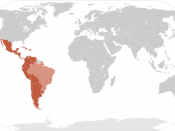In most societies during the twentieth Century, new ways of analyzing traditional gender roles have begun to evolve out of a variety of movements both within art and culture studies and communications. Semiotics, or the study of signs has emerged as one of the most "powerful cultural analysis tools of the twentieth Century" . Semiotics has been used to document and support traditional gender roles within a variety of cultures. The signs of Husband and Wife respectively, have undergone huge ideological shifts in some parts of the world, however within Latin American society they still often used to represent a system of values and a distribution of power that have remained relatively unchanged despite recent eras of social progress. This is illustrated fairly well in the movie "Amores Perros" as the terms Husband and Wife are utilized throughout the movie as signs that represent and suggest traditional values and gender roles that are still based on signified characteristics from the time of the Conquistadors.
The power of language and symbolism is often overlooked within societies trying to bring about major cultural changes, in areas that have long been dominated by traditional views. The signifiers and the signified are used as examples of traditional behavioral characteristics and belief systems that have not paralleled woman's advances within other areas of Latin American society.
The study of signs, or semiotics is concerned with the study of language and labels or signs given to physical and abstract entities within the supposedly real world. It looks at how perceptions of different signs are socially constructed and given a certain level of social meaning, which goes far beyond their mere physical characteristics . An example of this can be a toothbrush, which when referred to as a sign contains two elements the signifier (the actual...


